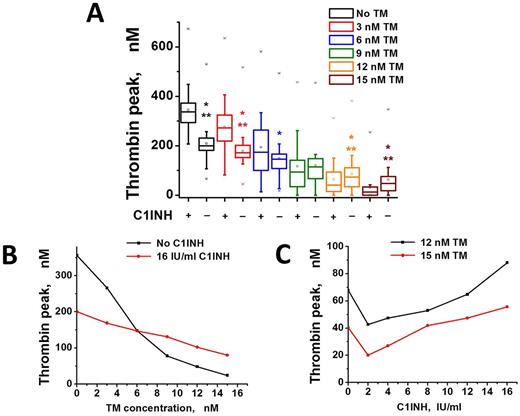Abstract
Introduction. Human C1-esterase inhibitor (C1INH) is a multifunctional plasma glycoprotein with a broad spectrum biological activities, best known for its role in regulation of the classical complement pathway, contact activation system and its essential roles in the coagulation and fibrinolytic cascades [1,2]. The main targets of C1INH are C1 esterase, Factors XIa and XIIa, kallikrein, thrombin and plasmin. Low levels of functional C1INH in plasma are considered to be the primary cause for hereditary angioedema (HAE) with symptoms of swelling in the face, throat, hands, feet and abdomen. HAE patients receive replacement therapy with plasma-derived C1INH products recently licensed in the US and EU for prophylactic and acute treatment of HAE [1]. Studies suggest that supra-physiological doses of C1INH can promote thrombotic events.. To date the use of C1INH at plasma concentrations exceeding normal have been proposed in a range of disease states including renal transplant, myocardial infarction and acute lung injury. However, the mechanism and concentration required to augment the risk of thromboembolic events remains unclear and therefore raises questions about the safety of high dose C1INH therapy. We evaluated all possible sites of the C1INH concentration-dependent interaction with the coagulation system and here we focus on a hypothesis that supra-physiological concentrations of C1INH alter the anticoagulant protein C system. To study the interactive role of C1INH and the protein C pathway we performed thrombin generation assays (TGA) on plasmas from both male and female healthy donors in the presence of supra-physiologic concentrations of C1INH and increasing concentrations of thrombomodulin (TM).
Methods. Platelet poor plasma (PPP) was isolated by centrifugation from blood of 20 healthy donors and mixed with 16 IU/ml of C1INH or with the same volume of buffer. The used C1INH concentration was 16 times bigger than normal values. Concentrations of TM added to the plasma samples were equal to 3, 6, 9, 12 and 15 nM. 4.5 pm tissue factor-induced thrombin generation was performed by continuous measurement of thrombin proteolytic activity of thrombin-specific substrate Z-Gly-Gly-Arg-AMC added to PPP before induction of coagulation. Thrombin peak was calculated using Origin software. Wilcoxon and sign paired tests with P=0.05 were used to obtain statistics.
Results and conclusions. C1INH significantly reduced thrombin peak up to 2 times in the absence and at the lowest concentrations of TM (3 and 6 nM). Addition of 9 nM TM caused disappearance of the difference between the samples with and without C1INH. Finally, in the presence of 12 and 15 nM of TM, C1INH significantly enhanced thrombin peak (Figure 1A, B). Figure 1B demonstrates that reducing C1INH concentration can bring the thrombin peak back to the values obtained without C1INH presence. These results indicate that presence of TM crucially change the action of C1INH on coagulation and explains how supra-physiological concentrations of coagulation inhibitor may cause thrombosis in certain clinical situations.
Figure 1. A: Effect of elevation of C1INH concentration on thrombin peak. Statistics was obtained using Wilcoxon (*) and Sign (**) paired tests with P value equal to 0.05 from 20 healthy donors. B: Representative dependence of thrombin peak on TM concentration with and without the presence of 16 IU/ml C1INH. C: representative dependence of Thrombin peak on C1INH concentration in the presence of TM.
References
1. Karnaukhova E (2013) C1-esterase inhibitor: Biological activities and therapeutic applications. J. Hematol. Thromboemb. Dis. 1(3): 1-7.
2. Davis AE 3rd, Lu F, Mejia P (2010)C1 inhibitor, a multi-functional serine protease inhibitor. Thromb Haemost 104: 886-893, 2010.
3. Gandhi PK, Gentry WM, Bottorff MB (2012) Thrombotic events associated with C1 esterase inhibitor products in patients with hereditary angioedema: investigation from the United States Food and Drug Administration adverse event reporting system database. Pharmacotherapy 32(10): 902-9.
No relevant conflicts of interest to declare.
Author notes
Asterisk with author names denotes non-ASH members.


